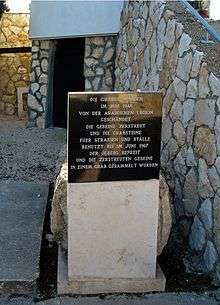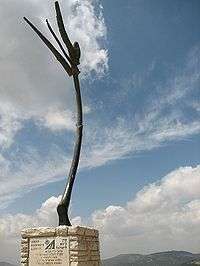Else Lasker-Schüler
| Else Lasker-Schüler | |
|---|---|
 Else Lasker-Schüler shortly after her first marriage | |
| Born |
February 11, 1869 Elberfeld, North German Confederation (today Wuppertal, Germany) |
| Died |
January 22, 1945 (aged 75) Jerusalem, Mandatory Palestine |
| Occupation | Poet |
Else Lasker-Schüler (February 11, 1869 – January 22, 1945) was a Jewish German poet and playwright famous for her bohemian lifestyle in Berlin. She was one of the few women affiliated with the Expressionist movement. Lasker-Schüler fled Nazi Germany and lived out the rest of her life in Jerusalem.[1]
Biography
Schüler was born in Elberfeld, now a district of Wuppertal. Her mother, Jeannette Schüler (née Kissing) was a central figure in her poetry, and the main character of her play Die Wupper was inspired by her father, Aaron Schüler, a Jewish banker.
In 1894, Else married the physician and occasional chess player Jonathan Berthold Lasker (the older brother of Emanuel Lasker, a World Chess Champion) and moved with him to Berlin, where she trained as an artist. On August 24, 1899 her son Paul was born and her first poems were published. She published her first full volume of poetry, Styx, three years later, in 1902. On April 11, 1903, she and Berthold Lasker divorced and on November 30, she married Georg Lewin. His pseudonym, Herwarth Walden, was her invention.
Lasker-Schüler's first prose work, Das Peter-Hille-Buch, was published in 1906, after the death of Hille, one of her closest friends. In 1907, she published the prose collection Die Nächte der Tino von Bagdad, followed by the play "Die Wupper" in 1909, which was not performed until later. A volume of poetry called Meine Wunder, published in 1911, established Lasker-Schüler as the leading female representative of German expressionism.
After separating from Herwarth Walden in 1910 and divorcing him in 1912, she found herself penniless and dependent on the financial support of her friends, in particular Karl Kraus. That year, she met Gottfried Benn. An intense friendship developed between them which found its literary outlet in a large number of love poems dedicated to him. The death of her son in 1927, however, sent her into a deep depression.
Despite winning the Kleist Prize in 1932, as a Jew she was physically harassed and threatened by the Nazis. She emigrated to Zürich but there, too, she could not work. She traveled to Palestine in 1934 and finally settled in Jerusalem in 1937. In 1938 she was stripped of her German citizenship and the outbreak of World War II prevented any return to Europe. Her Bohemian lifestyle and eccentric fashion made life in Jerusalem difficult. She tended to spend whatever money she had all at once which made her go for days without food or shelter. Heinz Gerling and the poet Manfred Schturmann came to her aid. Gerling opened a bank account for her and arranged for regular payments to cover her expenses whereas Schturmann edited her work and helped with her dealings with publishers. After her death Schturmann became the trustee of her legacy and during the 1950s and '60s dealt extensively with publishers in East and West Germany, Switzerland and Austria who wished to publish her works.
In 1944 Lasker-Schüler's health deteriorated. She suffered a heart attack on January 16, and died in Jerusalem on January 22, 1945. She was buried on the Mount of Olives.[2]


Literary career

Lasker-Schüler left behind several volumes of poetry and three plays, as well as many short stories, essays and letters. During her lifetime, her poems were published in various magazines, among them the journal Der Sturm edited by her second husband, and Karl Kraus' 'Fackel. She also published many anthologies of poetry, some of which she illustrated herself. Examples are:
- Styx (first published volume of poetry, 1902)
- Der siebente Tag (second volume of poetry, 1905)
- Meine Wunder (first edition, 1911)
- Gesammelte Gedichte (1917)
- Mein blaues Klavier (1943)
Lasker-Schüler wrote her first and most important play, Die Wupper, in 1908. It was published in 1909 and the first performance took place on April 27, 1919 at the Deutsche Theater in Berlin.
A large part of her work is composed of love poetry, but there are also deeply religious poems and prayers. Transitions between the two are often quite fluid. Her later work is particularly rich in biblical and oriental motifs. Lasker-Schüler was very free with regard to the external rules of poetic form, however her works thereby achieve a greater inner concentration. She was also not averse to linguistic neologisms.
A good example of her poetic art is "Ein alter Tibetteppich" ("An old Tibetan rug"), a poem which was reprinted many times after its first publication in Sturm, the first of these being in Fackel.
"Ein alter Tibetteppich" |
"An old Tibetan rug" |
Another translation of the Tibetan Carpet:
Your soul that's sewn in love and mine
Threads in Carpet-Tibet-Land entwine.
Colours in love, ray within ray,
Stars courting each other across the sky.
Our feet rest on such weaving rare
Thousands-on-thousands-of stitches-far.
On musk-plant-throne, sweet Lama's son,
How long do my lips kiss your lips
And cheek to cheek as brightly-buttoned seasons run?
—Felix de Villiers (copyright)
Influence
The 20th-century Scottish poet Hugh MacDiarmid included a translation of an extract from Lasker-Schüler's work in his long poem A Drunk Man Looks at the Thistle, 1926. (Lines 401–410.)
Commemoration

There is a memorial plaque to Else Lasker-Schüler at Motzstraße 7, Berlin-Schöneberg, where she lived from 1924 to 1933. Part of this street was renamed Else-Lasker-Schüler-Straße in 1996. In Elberfeld in Wuppertal there is now a school named after her (The "School without Racism"), and a memorial stele was erected on Herzogstraße, Wuppertal.
The Else-Lasker-Schüler-Society was founded 1990 in Wuppertal by journalist Hajo Jahn. In more than 20 international symposias from Breslau to Tel Aviv, the works of the poet wer introduced and discussed in relation to the relevance for the presence and future.
In Jerusalem, there is a small street named for Else Lasker-Schüler in the neighborhood of Nayot - Rehov Else. Perched on a ridge in the Jerusalem Forest, very close to the Kennedy Memorial (Yad Kennedy), was a sculpture in her honor resembling a slender tree trunk with wings. It was placed there in 1997, and was stolen, probably by metal thieves, in July 2007.
In 2007, her final days in Jerusalem were commemorated in the BBC radio play MY BLUE PIANO by the Scottish playwright Marty Ross (Radio 4 2007) which combined the facts of her dying days with the fantasies of her inner life.[3]
Film
- Ich räume auf ("Putting Things Straight") Germany 1979,[4] German actress Gisela Stein plays the part of Else Lasker-Schüler fighting against her editors. The film was first broadcast by: Westdeutscher Rundfunk Köln, director: Georg Brintrup
- Mein Herz – niemandem! (1997) by Helma Sanders-Brahms features Lena Stolze as the poet, and climaxes with the paradox of her deep bond with Gottfried Benn who became a Nazi.
References
- ↑ Three Plays, Else Lasker-Schuler Archived August 7, 2007, at the Wayback Machine. (Archived)
- ↑ Kiss of July, Haaretz
- ↑ This can be heard at My Blue Piano Archived July 14, 2011, at the Wayback Machine.
- ↑ Ich räume auf
Translations
- Else Lasker-Schüler, Abschied (3), English tr. Translations of Dead German Poets (2013)
Further reading
- Avidov Lipsker, Red Poem\ Blue Poem: Seven Essays on Uri Zvi Grinberg and Two Essays on Else Lasker-Schüler, Bar Ilan University Press, Ramat-Gan 2010.
- Feldman, D., Shlesinger, M. Shedletzky, I. (2010). Five Hebrew Translations of Else Lasker-Schüler's Poem "An mein Kind". Nashim. Number 19: 176–198.
- 1913, The Year Before the Storm by Florian Illies.
External links
- ELS Gesellschaft
- Online list of publications
- Grace Andreacchi
- "Ein alter Tibetteppich" - poem of the month (in German)
- Exile Archives
- Elke Lasker-Schüler Collection of letters at the Leo Baeck Institute, New York, NY
- Works by Else Lasker-Schüler at Project Gutenberg
- Works by or about Else Lasker-Schüler at Internet Archive